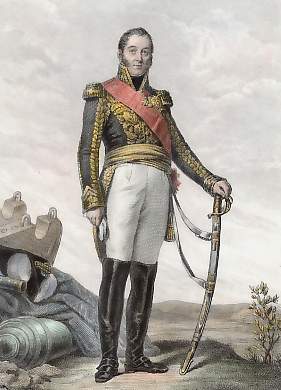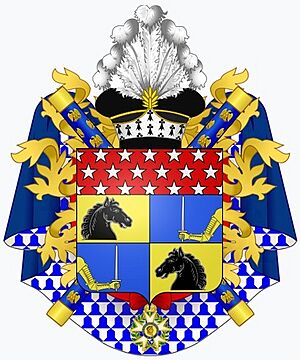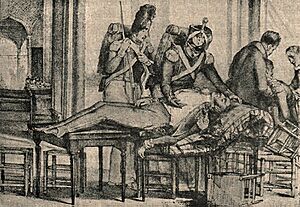Édouard Mortier, Duke of Treviso facts for kids
Quick facts for kids
Marshal
Édouard Mortier
Duke of Treviso
|
|
|---|---|

Portrait by Édouard Dubufe, 1844
|
|
| Prime Minister of France | |
| In office 18 November 1834 – 12 March 1835 |
|
| Monarch | Louis Philippe I |
| Preceded by | Hugues-Bernard Maret |
| Succeeded by | Victor de Broglie |
| Minister of War | |
| In office 18 November 1834 – 12 March 1835 |
|
| Preceded by | Simon Bernard |
| Succeeded by | Henri de Rigny |
| Personal details | |
| Born | 13 February 1768 Le Cateau, France |
| Died | 28 July 1835 (aged 67) Paris, France |
| Resting place | Père Lachaise Cemetery |
| Awards | Grand Cordon of the Legion of Honor Grand Cross of the Military Order of Jesus Christ |
| Signature |  |
| Military career | |
| Allegiance | |
| Service/ |
Army |
| Years of service | 1791–1835 |
| Rank | General of division |
| Commands held | VIII Corps V Corps |
| Battles/wars | French Revolutionary Wars Napoleonic Wars |
Édouard Mortier (born February 13, 1768 – died July 28, 1835) was a famous French military leader. He became a Marshal of the Empire under Napoleon I. This was a very high rank in the French army. Mortier fought in important wars like the French Revolutionary Wars and the Napoleonic Wars.
Later in his life, he also served as a top government official. He was the Minister of War and even the Prime Minister of France from 1834 to 1835. Sadly, he was one of many people killed during an attack on King Louis Philippe I in 1835.
Contents
Early Life and Start in the Army
Édouard Mortier was born in a town called Le Cateau in northern France. His father was a draper, which means he sold cloth. Édouard studied at a college in Douai.
When the French Revolution began in 1789, he joined the National Guard in Dunkirk. This was a citizen army. By September 1791, he was chosen as a captain of a group of volunteers.
Fighting in the French Revolutionary Wars
When the War of the First Coalition started in 1792, Mortier joined the French army. He fought in many battles in the Low Countries (like modern-day Belgium and Netherlands). He was at the Battle of Jemappes and the Siege of Namur in 1792. He also fought at the Battle of Neerwinden in 1793 and the Battle of Fleurus in 1794.
Later, he moved to the Army of Sambre and Meuse near the Rhine River. He played a key role in capturing the city of Maastricht. Mortier was also chosen to handle the surrender of the Fortress of Mainz, which he did successfully.
In 1799, during the War of the Second Coalition, Mortier was promoted to brigade general. He served under General Soult at the Second Battle of Zurich. He led 8,000 soldiers in an attack on Zurich. In October, he became a general of division, a very important rank.
Serving During the Napoleonic Wars
In 1803, Napoleon Bonaparte, who was then the leader of France, put Mortier in charge. Mortier led an army to invade the Electorate of Hanover, a German state. He successfully took control of Hanover. Because of this success, Napoleon made Mortier one of the first marshals in 1804. This was a huge honor. In 1805, Mortier became the commander of the foot soldiers in Napoleon's special army, the Imperial Guard.
Campaigns and Challenges
During the War of the Third Coalition, Mortier commanded a large group of soldiers called a corps. He did very well in the Ulm campaign. Later, Napoleon put him in charge of a new corps, the VIII Corps.
In one battle, the Battle of Dürrenstein (November 11, 1805), Mortier's troops were in a tough spot. They were caught between two Russian armies. Luckily, another French division arrived just in time to save them. Both sides had heavy losses in this fierce battle. After this, Mortier was given command of the V Corps.
Conquering Hesse
When the War of the Fourth Coalition began in 1806, Mortier was again given command of the VIII Corps. Napoleon ordered him to conquer the Electorate of Hesse. Mortier was to take the capital city of Kassel and arrest its ruler. This was a difficult task because Hesse was supposed to be neutral.
On November 1, the French army occupied Kassel and took many valuable things. Mortier claimed he was there to protect Hesse, but he also accused them of helping France's enemies.
Mortier left some soldiers in Hesse and then helped in other battles in Prussia. He helped capture the cities of Hamelin and Nienburg. In 1807, he led part of Napoleon's army at the Battle of Friedland. He also helped in the sieges of Stralsund and Kolberg.
In 1808, Napoleon rewarded Mortier for his bravery. He gave him the title "Duke of Treviso". This was a special honor that could be passed down in his family.
Battles in Spain and Russia
In October 1808, Mortier went to Spain to help recapture Madrid. He led the V Corps in battles like the Battle of Somosierra and the Second Siege of Zaragoza. He also fought in the Arzobispo and helped win the Ocaña, where he was injured. Before returning to France in 1811, he served in southern Spain, including the Siege of Badajoz.
During Napoleon's invasion of Russia in 1812, Mortier commanded the Young Guard. After the Battle of Borodino, he became the governor of French-occupied Moscow. When the French army had to retreat, he was ordered to destroy parts of the city. He then fought bravely in the difficult retreat battles, like Krasnoi and the Berezina.
In 1813, Mortier again led the Young Guard in several battles during the German campaign. These included Lützen, Bautzen, Dresden, and Leipzig. In 1814, during the defense of France, he commanded the Old Guard in battles like Montmirail and the final Battle of Paris.
After Napoleon
After Napoleon gave up his power in April 1814, Mortier supported the return of the French kings. When Napoleon briefly returned to power in 1815 (the Hundred Days), Mortier helped the king leave the country. He then joined Napoleon again and was given command of the Imperial Guard. However, he was too ill to fight in the Waterloo campaign.
Later Career and Tragic Death
After the kings returned to power for a second time, Mortier was asked to be part of a court trial for another marshal, Michel Ney. He didn't want to, and for a while, he was out of favor. But in 1816, he received a new command. In 1819, he became a member of the Chamber of Peers, a group of important noblemen. In 1825, he received the Order of the Holy Spirit, France's highest honor.
He supported the July Revolution in 1830, which brought King Louis Philippe to power. From 1830 to 1831, he was France's Ambassador to Russia. From 1834 to 1835, he served as the Minister of War and the Prime Minister of France.
How Mortier Died
On July 28, 1835, Mortier was with King Louis-Philippe at a parade in Paris. It was an annual event to celebrate the July Revolution. As the royal group passed along the Boulevard du Temple, shots were fired from a house window.
Eighteen people were killed, including Marshal Mortier, and 22 were injured. The king himself only had a minor wound. The weapon used was a homemade volley gun, which could fire many bullets at once. It was built by a man named Giuseppe Marco Fieschi, who wanted to kill the king. Four of the gun's barrels burst when fired, and Fieschi was badly hurt. He was quickly caught and later put on trial with two others. They were all executed in February 1836.
Family Life
Mortier was married to Eve Anne Hymmès. They had six children together:
- Caroline Mortier de Trevise (1800–1842)
- Sophie Malvina Joséphine Mortier de Trévise (born 1803)
- Napoléon Mortier de Trévise (1804–1869), who became the 2nd Duke of Trévise
- Edouard (1806–1815)
- Louise (1811–1831)
- Eve-Stéphanie Mortier de Trévise (1814–1831)
See also
 In Spanish: Édouard Mortier para niños
In Spanish: Édouard Mortier para niños
- Édouard Mortier para niños (in Spanish)




